THE ECCA PROJECT: FINAL REPORT
#3 ECCA Report
February 2023
Tags: European Charter for Regional or Minority Languages, school, activities, youth
Authorship: Elija Lutze, Universitat de València / Xarxa Vives d’Universitats (Vives Universities Network)
In this last report, we summarize the tools that the ECCA project has been able to develop since the 2019-2020 academic year in order to contribute to the dissemination of the European Charter of Regional or Minority Languages and to sensitize European citizens to the value of linguistic diversity through education. Month by month, we will inform you about the progress of the closing ceremony, on October 1st in Trento. Next, we reflect on the role of Catalan and the Xarxa Vives d’Universitats in projects such as ECCA. Finally, we draw conclusions from the project and propose some personal considerations for future projects.
Read the original article in Catalan here.
Share this publication:

